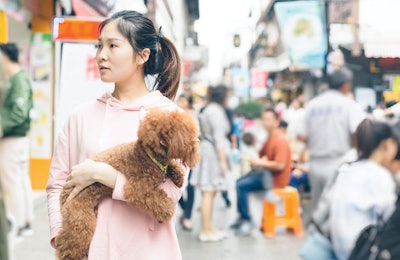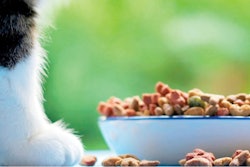
China is a hot topic in the pet food world, and with recent updates to certain regulations it behooves any interested pet food manufacturer to take a look at what’s changed and how to navigate the current export/import climate.
The General Administration of Customs People’s Republic of China (GACC) issued Decree 243 on November 23, 2018, which amends "Supervision and Management Measures for the Inspection and Quarantine of Import and Export Feed and Feed Additive (Decree 118)" and deletes import registration license requirements on feed and feed additives (required by Decree 118, article 16). Enforcement began immediately.
What does Decree 243 do?
According to Ring One (Beijing) Technology Consulting Ltd., professional feed ingredients, additives and pet food regulatory specialists, Decree 243 does not abolish feed and feed additives MOA (Memorandum of Association) registration, but cancels MOA registration re-examining during customs clearance. MOA registration is still required by the Ministry of Agriculture of the People’s Republic of China (the Ministry), but China Customs will not examine MOA registrations twice during the clearance process.
According to Articles 15 and 16 of the new Decree 118, "If the permit for the quarantine of import animals and plants is required for the import feeds, the enterprise concerned shall, according to relevant regulations, transact formalities for the permit … The consigner or its agent shall, prior to or upon the entry of import feeds, apply to the inspection and quarantine agencies for the quarantine inspection of the feeds with relevant certificate of origin, business contract, letter of credit, bill of lading and invoices. Besides, the consigner or its agent shall, according to different requirements for various products, present the permit for the quarantine of import animals and plants, inspection and quarantine certificates of the exporting countries or regions."
Additionally, according to regulations from the Ministry (see "Administrative Measures on Feed and Feed Additives," "MOA Regulation on Feed and Feed Additive Import Registration" and "Administrative Measures for Pet Feed"), feed and feed additives sold in China should be registered by the Ministry.
Consequences of operating without the proper registration
For enterprises operating feed or feed additive businesses without registrations, the feed administration department at the county level shall order them to make corrections and will confiscate illegal gains and illegally operated products. They will also impose a fine of RMB2,000–RMB20,000 (US$291.15–US$2,911.50) if the value of goods is less than RMB10,000 (US$1,455.75), or a fine of two to five times of the value of the goods if the value of goods is more than RMB10,000. If the circumstance is grave, the operation in question shall be ordered to stop and the State Administration for Industry & Commerce of the People’s Republic of China (SAIC) shall be informed to revoke the delinquent enterprise’s business license. If a crime is constituted, criminal responsibility shall be investigated according to law.
Imported animal-origin feed (including pet food) is the primary quarantined product by China Customs and the Ministry. Pet food is directed to consumers and will be supervised by the Industrial and Commercial Administration Department; therefore, Ring One strongly recommends obtaining MOA registration before export to China.
Exporting pet food to the Chinese market

Whether you’re considering traditional export channels or e-commerce, doing business in China requires a solid grasp of the various rules and regulations to be followed. | narvikk I iStockPhoto.com
According to Feed China Registered License Center, there are two ways for pet food to enter the Chinese market: through traditional exporting channels and through cross-border e-commerce channels.
Traditional exporting channels
The procedure for exporting pet food to China through traditional exporting channels includes the following steps:
- Check whether the country that the pet food is being exported from has permission to export pet food to China.
- Approach the exporting country’s competent authority to express interest so that the authority can gauge demand for exporting to China and act accordingly.
- Check whether the ingredients in the pet food can be exported to China.
If the pet food manufacturer is exporting from a country with access to the Chinese market, the exporting company needs to obtain an import registration license from the MOA through an agent in China (this process usually takes six months) and be on the GACC Approved List (the “Approved Country [Region] List for Imported Feed, Pet Food and Supplementary Feed Product”).
There are two types of access to the Chinese market that can be granted to countries exporting pet food and animal feed to China:
- Full market access: In countries with full market access, all exporters are assumed to have automatic access to the Chinese market. Products that are on the GACC’s Approved List are permitted to be exported to China and the relevant manufacturing facilities are required to be registered with the GACC, although this can be done at or after the time of export.
- Partial market access: In countries with partial market access exporters are not assumed to have automatic access to the Chinese market. Exporters must first register their manufacturing facilities with the GACC before exporting. Products under this category are only allowed to be exported by manufacturers that have already registered with the GACC.
New Zealand is currently the only country with full market access, meaning exporting companies and relevant manufacturing facilities from New Zealand not registered with the GACC at the time of export are able to export products to China and register at the time of export or afterwards.
As the Approved List is often updated, exporters should register their manufacturing facilities with the GACC through a recommendation from the competent authority in their own country (generally the same authority that the exporter registers its initial interest in exporting with). GACC’s Approved List is only available in Chinese. It is also important to be aware that certain types of pet food, including pet snacks and pet chews, do not normally require an MOA import license. Pet food exporters should check with the MOA’s regulations on feed and feed additives to confirm whether an import license is required for their products. In addition, imported pet food must match the MOA’s specific labeling and hygiene requirements for pet food, as stated in Decree 20, which was published on April 27, 2018, and came into effect on June 1, 2018.
Cross-border e-commerce channels
An alternative to exporting pet food through traditional exporting channels is to export it through cross-border e-commerce channels.
Pre-packaged dog and cat food for retail are both listed on the “Cross-Border E-commerce Imported Retail Commodity Positive List.” However, all pet food exported to China via cross-border e-commerce channels must comply with the same GACC requirements as that exported to China via traditional exporting channels: exporters need to acquire export access permission and be registered before dispatching products to a port. The MOA’s import registered license will need to be obtained as well, after September 1, 2019, as stated in Decree 20.
For companies in countries with no market access, if the company’s products are manufactured in a country with access, it could export through the country of manufacture instead of the country where the company is registered.
Ken Jiao is a consulting manager for Ring One (Beijing) Technology Consulting Ltd., Tianjin Branch. www.ringone.cn. Flora Lyu is a consultant with Feed China Registered License Center, a subordinate division of China Agricultural (Beijing) Consulting Co. Ltd. www.feedchina.net/en/.















